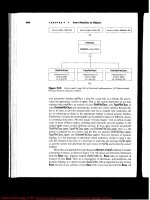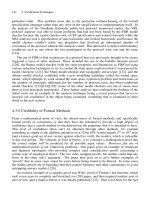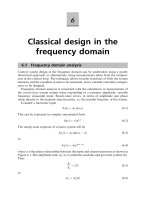SOFTWARE ENGINEERING Chapter 6 – Software Architecture Design
Bạn đang xem bản rút gọn của tài liệu. Xem và tải ngay bản đầy đủ của tài liệu tại đây (16.02 MB, 56 trang )
SOFTWARE
ENGINEERING
Chapter 6 – Software Architecture Design
Jul 2013
Chapter 6. Software architecture design
Topics covered
• Architectural design decisions
• Architectural views
• Architectural patterns
• Application architectures
2
Jul 2013
Chapter 6. Software architecture design
3
Software architecture
• The design process for identifying the sub-systems
making up a system and the framework for sub-system
control and communication is architectural design.
• The output of this design process is a description of the
software architecture.
Jul 2013
Chapter 6. Software architecture design
4
Architectural design
• An early stage of the system design process.
• Represents the link between specification and design
processes.
• Often carried out in parallel with some specification
activities.
• It involves identifying major system components and their
communications.
Jul 2013
Chapter 6. Software architecture design
5
The architecture of a packing robot control
system
Jul 2013
Chapter 6. Software architecture design
6
Architectural abstraction
• Architecture in the small is concerned with the
architecture of individual programs. At this level, we are
concerned with the way that an individual program is
decomposed into components.
• Architecture in the large is concerned with the architecture
of complex enterprise systems that include other systems,
programs, and program components. These enterprise
systems are distributed over different computers, which
may be owned and managed by different companies.
Jul 2013
Chapter 6. Software architecture design
7
Decomposition
• Software systems: complexity problem <= inter-
relationship
• Decomposition OR modularizing:
• System (high complexity) = set of small program (low complexity)
• Goals:
• Maximizing cohesion
• Minimizing coupling
1
component
2
3
Cohesion: degree of
communication taken place
among the module’s elements
4
component
High cohesion
5
Bridge
6
Low coupling
b
b
Steel
truss
component
High coupling
r
Coupling: degree of
communication among modules
Jul 2013
Chapter 6. Software architecture design
8
Begin Selecting a Basic Architecture
• 1. Develop a mental model of the application at a high
level.
• as if it were a small application
• e.g., personal finance application
• “works by receiving money or paying out money, in any order, controlled
through a user interface”.
• 2. Decompose into the required components.
• look for high cohesion & low coupling
• e.g., personal finance application
• decomposes into Assets, Suppliers, & Interface.
• 3. Repeat this process for the components.
Jul 2013
Chapter 6. Software architecture design
9
Advantages of explicit architecture
• Stakeholder communication
• Architecture may be used as a focus of discussion by system
stakeholders.
• System analysis
• Means that analysis of whether the system can meet its nonfunctional requirements is possible.
• Large-scale reuse
• The architecture may be reusable across a range of systems
• Product-line architectures may be developed.
Jul 2013
Chapter 6. Software architecture design
10
Architectural representations
• Simple, informal block diagrams showing entities and
relationships are the most frequently used method for
documenting software architectures.
• But these have been criticised because they lack
semantics, do not show the types of relationships
between entities nor the visible properties of entities in the
architecture.
• Depends on the use of architectural models.The
requirements for model semantics depends on how the
models are used.
Jul 2013
Chapter 6. Software architecture design
11
Box and line diagrams
• Very abstract - they do not show the nature of component
relationships nor the externally visible properties of the
sub-systems.
• However, useful for communication with stakeholders and
for project planning.
Jul 2013
Chapter 6. Software architecture design
12
Use of architectural models
• As a way of facilitating discussion about the system
design
• A high-level architectural view of a system is useful for
communication with system stakeholders and project planning
because it is not cluttered with detail. Stakeholders can relate to it
and understand an abstract view of the system. They can then
discuss the system as a whole without being confused by detail.
• As a way of documenting an architecture that has been
designed
• The aim here is to produce a complete system model that shows
the different components in a system, their interfaces and their
connections.
Jul 2013
Chapter 6. Software architecture design
13
Architectural design decisions
• Architectural design is a creative process so the process
differs depending on the type of system being developed.
• However, a number of common decisions span all design
processes and these decisions affect the non-functional
characteristics of the system.
Jul 2013
Chapter 6. Software architecture design
14
Architectural design decisions
• Is there a generic application architecture that can be
•
•
•
•
•
•
•
used?
How will the system be distributed?
What architectural styles are appropriate?
What approach will be used to structure the system?
How will the system be decomposed into modules?
What control strategy should be used?
How will the architectural design be evaluated?
How should the architecture be documented?
Jul 2013
Chapter 6. Software architecture design
15
Architecture reuse
• Systems in the same domain often have similar
architectures that reflect domain concepts.
• Application product lines are built around a core
architecture with variants that satisfy particular customer
requirements.
• The architecture of a system may be designed around
one of more architectural patterns or ‘styles’.
• These capture the essence of an architecture and can be
instantiated in different ways.
• Discussed later in this lecture.
Jul 2013
Chapter 6. Software architecture design
16
Architecture and system characteristics
• Performance
• Localise critical operations and minimise communications. Use
large rather than fine-grain components.
• Security
• Use a layered architecture with critical assets in the inner layers.
• Safety
• Localise safety-critical features in a small number of sub-systems.
• Availability
• Include redundant components and mechanisms for fault tolerance.
• Maintainability
• Use fine-grain, replaceable components.
Jul 2013
17
Chapter 6. Software architecture design
Choosing an Architecture
Table 5.4 Fuzzy method for comparing architectures [3]
Architecture alternative
Quality
Weight
1-10
1. State design
pattern
2. Ad-hoc GUI
driven
3. State-transition
table
High=9; Medium=5; Low=2
Extension
9
High
Low
Medium
Change
7
High
Low
Medium
Simplicity
5
Low
High
Medium
Efficiency:
speed
5
Medium
High
Medium
Efficiency:
storage
2
Low
Low
Medium
183
126
140
Total (higher=better):
Jul 2013
Chapter 6. Software architecture design
18
Architectural views
• What views or perspectives are useful when designing
and documenting a system’s architecture?
• What notations should be used for describing architectural
models?
• Each architectural model only shows one view or
perspective of the system.
• It might show how a system is decomposed into modules, how the
run-time processes interact or the different ways in which system
components are distributed across a network. For both design and
documentation, you usually need to present multiple views of the
software architecture.
Jul 2013
Chapter 6. Software architecture design
19
4 + 1 view model of software architecture
• A logical view, which shows the key abstractions in the
•
•
•
•
system as objects or object classes.
A process view, which shows how, at run-time, the
system is composed of interacting processes.
A development view, which shows how the software is
decomposed for development.
A physical view, which shows the system hardware and
how software components are distributed across the
processors in the system.
Related using use cases or scenarios (+1)
Jul 2013
Chapter 6. Software architecture design
20
Architectural patterns
• Patterns are a means of representing, sharing and
reusing knowledge.
• An architectural pattern is a stylized description of good
design practice, which has been tried and tested in
different environments.
• Patterns should include information about when they are
and when the are not useful.
• Patterns may be represented using tabular and graphical
descriptions.
Jul 2013
Chapter 6. Software architecture design
21
The Model-View-Controller (MVC) pattern
Name
MVC (Model-View-Controller)
Description
Separates presentation and interaction from the system data. The system is
structured into three logical components that interact with each other. The
Model component manages the system data and associated operations on
that data. The View component defines and manages how the data is
presented to the user. The Controller component manages user interaction
(e.g., key presses, mouse clicks, etc.) and passes these interactions to the
View and the Model. See Figure 6.3.
Example
Figure 6.4 shows the architecture of a web-based application system
organized using the MVC pattern.
Used when there are multiple ways to view and interact with data. Also used
when the future requirements for interaction and presentation of data are
unknown.
Allows the data to change independently of its representation and vice versa.
Supports presentation of the same data in different ways with changes made
in one representation shown in all of them.
Can involve additional code and code complexity when the data model and
interactions are simple.
When used
Advantages
Disadvantages
Jul 2013
Chapter 6. Software architecture design
The organization of the Model-ViewController
22
Jul 2013
Chapter 6. Software architecture design
23
Web application architecture using the MVC
pattern
Jul 2013
Chapter 6. Software architecture design
24
Layered architecture
• Used to model the interfacing of sub-systems.
• Organises the system into a set of layers (or abstract
machines) each of which provide a set of services.
• Supports the incremental development of sub-systems in
different layers. When a layer interface changes, only the
adjacent layer is affected.
• However, often artificial to structure systems in this way.
Jul 2013
Chapter 6. Software architecture design
The Layered architecture pattern
Name
Layered architecture
Description
Organizes the system into layers with related functionality
associated with each layer. A layer provides services to the layer
above it so the lowest-level layers represent core services that
are likely to be used throughout the system. See Figure 6.6.
A layered model of a system for sharing copyright documents
held in different libraries, as shown in Figure 6.7.
Used when building new facilities on top of existing systems;
when the development is spread across several teams with each
team responsibility for a layer of functionality; when there is a
requirement for multi-level security.
Allows replacement of entire layers so long as the interface is
maintained. Redundant facilities (e.g., authentication) can be
provided in each layer to increase the dependability of the
system.
In practice, providing a clean separation between layers is often
difficult and a high-level layer may have to interact directly with
lower-level layers rather than through the layer immediately
below it. Performance can be a problem because of multiple
levels of interpretation of a service request as it is processed at
each layer.
Example
When used
Advantages
Disadvantages
25









